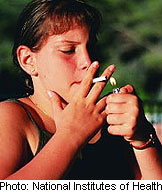

As smoking has become more expensive and inconvenient in the United States, fewer young people are lighting up, a new study shows.
“Because smoking initiation typically occurs before youth enter the workplace, smoke-free workplace laws likely affect smoking initiation by showing kids that adult smoking norms reject smoking,” said study first author Anna Song, an associate professor of psychological sciences at the University of California, Merced, Health Sciences Research Institute.
In a news release from the University of California, San Francisco (UCSF), Song said that the effects of smoke-free laws are similar or larger than other factors linked to smoking, such as age, race and poverty level.
The study looked at information collected in 1997 on the smoking habits of nearly 4,000 young people in the United States. The participants were between 12 and 18 years old.
Researchers monitored the teens for 11 years. During that time, state, county and citywide smoke-free laws became more prevalent and comprehensive. Cigarette taxes also increased during this time, the study found.
While the study can’t definitively show a cause-and-effect relationship, the researchers found that a 100 percent smoke-free environment seemed to lower the odds of young people taking up smoking by one-third. The number of new smokers during the study period dropped significantly, and the number of nonsmokers being exposed to harmful secondhand smoke also went down, the researchers reported.
During the study period, the number of people protected by smoking bans at work, restaurants and bars increased.
Young people living in areas where smoking bans were enforced in bars were 20 percent less likely to start smoking. Teens and young adults who already smoked when these laws were implemented smoked 15 percent fewer days each month, the study showed.
Findings were published Sept. 8 in the journal JAMA Pediatrics.
Senior study author Stanton Glantz, a professor of medicine at UCSF, said in the news release, “Smoke-free workplace laws have the most powerful effect on smoking initiation, equivalent to the deterrent impact of a $1.57 tax increase.”
Making cigarettes more expensive had an impact, too. The researchers noted that each 10-cent tax increase was followed by a 3 percent decline in the odds of starting to smoke. The federal tax increased from 24 cents per pack in 1995 to $1.01 per pack in 2009. The average state tax increased from nearly 33 cents per pack in 1995 to $1.20 per pack in 2009, the researchers said.
“Our results suggest that the $2 tax increase being discussed in the California legislature would cut youth smoking initiation nearly in half,” Glantz said.
More information
The U.S. National Institutes of Health provides more information on smoking and youth.
Source: HealthDay
Copyright © 2025 HealthDay. All rights reserved.

Leave a Reply